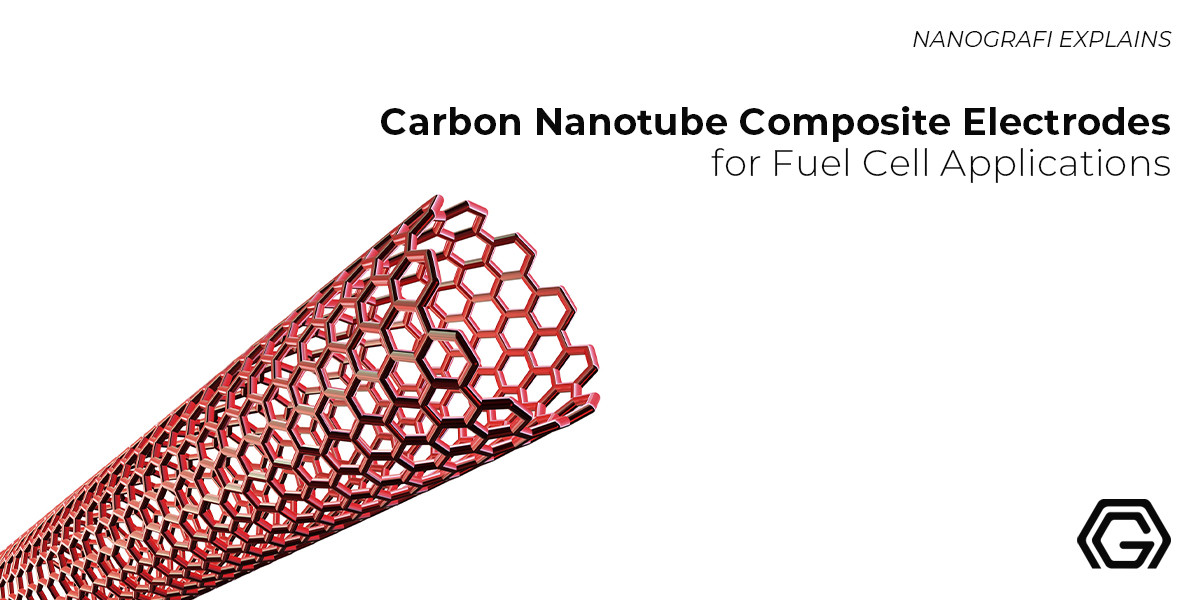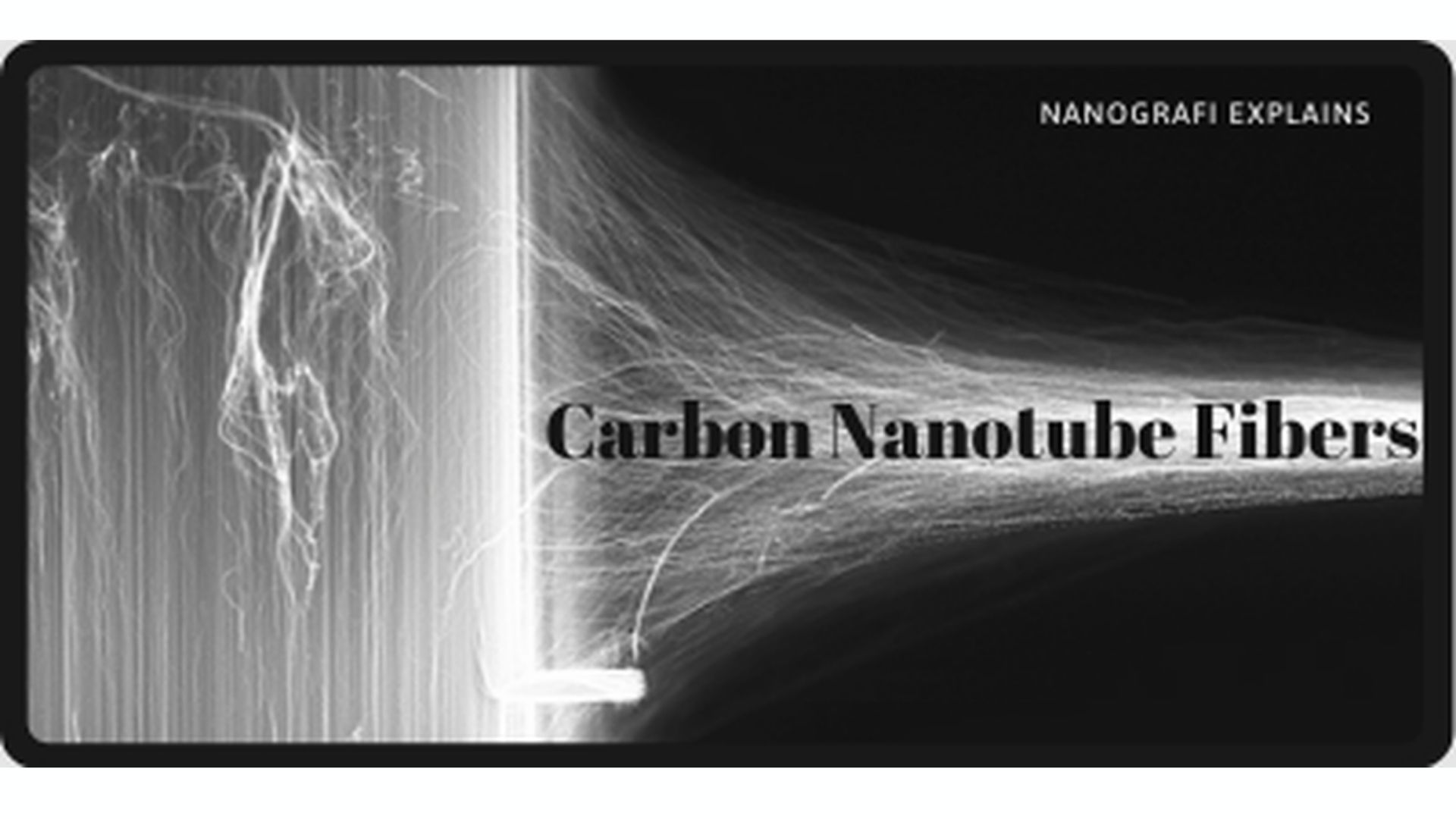Carbon Nanotube Composite Electrodes for Fuel Cell Applications
A fuel cell is one of the forms of an electrochemical cell where the process of conversion of chemical energy into electricity.
This entire process is carried out via redox reactions. These cannot be called batteries as they vary from the batteries because they are capable of producing continuous electricity in the long run until the supply of fuel and oxygen is limited. Carbon nanotube composite electrodes are highly essential for fuel cell applications owing to the excellent properties and features that they are capable of exhibiting. When these carbon nanotube composites are incorporated in fuel cells, they increase the functioning of fuel cells which in return increases their productivity and applications, both.
Introduction
An electrochemical cell that uses a pair of redox reactions for converting oxidizing agent (usually oxygen) and fuel's chemical energy (usually hydrogen) into electricity is known as a fuel cell. As compared to most batteries, the fuel cells are different as they need a continuous source of oxygen and fuel (commonly from the air) for sustaining the chemical reaction however the chemical energy in the battery commonly comes from metal and its oxides or ions that are already in the battery, other than the flow batteries. As long as there is a supply of oxygen and fuel, electricity can be continuously produced by the fuel cells.
The invention of fuel cells
In 1838, Sir William Grove invented the first fuel cells. In 1932, Francis Thomas Bacon invented the hydrogen-oxygen fuel cell and its first usage in the commercial area came a century later. Since the mid-1960s, there has been the utilization of the alkaline fuel cells, called the Bacon fuel cell too, in NASA for generating space capsules and satellites. The name Bacon fuel cells is after the inventor of the alkaline fuel cell. Since that time, there has been the usage of fuel cells in various other applications. Fuel cells are utilized in inaccessible or remote areas. They are utilized as backup and primary power for residential, industrial, and commercial buildings. They are also utilized for powering submarines, motorcycles, boats, buses, automobiles, and forklifts.
Fuel cells types
Fuel cells are of various types. All fuel cells are made up of an electrolyte, a cathode, and an anode. The electrolyte usually allows ions, and protons (positively charged hydrogen ions) to move between the fuel cell's two sides. A catalyst causes the fuel at the anode to go through the oxidation reactions that produce electrons and ions (usually positively charged hydrogen ions). The ions move through the electrolyte from anode to cathode. At the same moment, electrons produce direct current electricity by flowing through an external circuit from the anode to the cathode. Another catalyst forms water and probably other products at the cathode by causing oxygen, electrons, and ions to react.
Classification according to the type of the electrode
The electrolyte type that the fuel cells use is what classifies them, and the startup time also helps in it. Startup time can range from 10 minutes for the solid oxide fuel cells (SOFC) to 1 second for the proton-exchange membrane fuel cells (PEMFC, or PEM fuel cells). Flow batteries are a comparative technology in which recharging can regenerate the fuel. Comparatively small electrical potentials of 0.7 volts are produced by the individual fuel cells so the cells are placed in series or stacked for creating enough voltage for fulfilling the requirement of the applications. Fuel cells form heat, water, and electricity. Other emissions, extremely small amounts of nitrogen dioxide, and fuel sources determine the production. Generally, the fuel cell's energy efficiency is between 40-and 60%. Although, up to 85% of efficiencies can be achieved if waste heat is captured in a cogeneration scheme.
Features
An anode, a cathode, and an ion-conducting electrolyte are the fuel cell's primary components. For instance, an oxidant, usual oxygen is brought into the cathode compartment, and fuel like hydrogen is typically into the anode compartment. There is a total chemical driving force for hydrogen and oxygen to react for the production of water.
Chemical reaction
This chemical reaction is stopped in the fuel cell by the electrolyte that removes the fuel (H2) from the oxidant (O2). The electrolyte permits the transport of ions and also functions as a barrier to the diffusion of a gas. Half cell reactions take place at the cathode and anode, forming ions capable of transversing the electrolyte. For instance, if protons are conducted by the electrolyte, then the oxidization of H2 will occur at the anode for producing electrons and protons. After the protons migrate across the electrolyte, they will react with electrons and O2 at the cathode.
Progress in technology
Over the last decades, there has been huge progress done in fuel cell technology. There is still a small question that the design constraints placed on today's fuel cells by the available materials (electrodes/electrocatalysts and electrolytes) are the reason for them being costly and complex. For instance, it is a requirement of alkali hydroxides' extreme sensitivity to CO2 (carbon dioxide) that both the oxidant and the fuel should be free from the CO2 traces before their introduction into the alkali fuel cells.
Metal electrocatalysts’ Sensitivity
Just like that, trace CO’s removal in PEM fuel cells from the H2 fuel stream is necessitated by the extreme sensitivity of the precious metal electrocatalysts to CO (carbon monoxide). Failure of one auxiliary component needed for the operation of the fuel cell will most usually result in the fuel cell shut-down instead of the fuel cell's failure itself. There are many auxiliary components, ranging from gas purification to pressurization to cooling systems. Here, we have selectively highlighted the latest breakthroughs in both electrode and electrolyte materials for the systems of solid electrolyte, which is envisioned for highly simplifying the fuel cell design.
Working of fuel cells
There are many varieties of fuel cells although generally, they perform in the same manner. The cathode, the electrolyte, and the anode are the three adjacent segments that make up the fuel cells. There is an occurrence of 2 chemical reactions at three different segments' interfaces. The two reaction's net result is that an electric current is created, carbon dioxide or water is created, and fuel is consumed. The electric current can be utilized for powering the electrical devices, commonly known as the load.
Catalyst oxidization
Catalyst oxidizes the fuel typically hydrogen at the anode and converts the fuel into a negatively charged electron and a positively charged ion. An electrolyte is a specifically designed substance through which the electrons cant pass but ions can pass. The freed electrons create an electric current by traveling through a wire. Ions travel to the cathode through the electrolyte. The ions reunite with the electrons when they reach the cathode and the two form a reaction with a 3rd chemical, typically oxygen, for creating carbon dioxide or water.
Fuel cell’s design characteristics
-Gas diffusion layers are designed for resisting education.
-The most commonly used fuel is hydrogen.
-The electrolyte substance, which typically defines the fuel cell's type, can be produced from various substances like phosphoric acid, salt carbonates, and potassium hydroxide.
-With water being waste’s most common type, cathode catalyst which is usually nickel, converts ions into waste chemicals.
-Fuel is broken down by the anode catalyst, normally fine platinum powder, into ions and electrons.
Proton-exchange membrane fuel cells
The electrolyte solution separating the cathode and anode sides is contained by a proton-conducting polymer membrane, usually Nafion in the archetypical hydrogen–oxide proton-exchange membrane fuel cell (PEMFC) design. In the early 1970s, it was known as a solid polymer electrolyte fuel cell (SPEFC), and this was before anyone understood the proton-exchange mechanism. It should be noticed here that the synonyms proton-exchange mechanism and polymer electrolyte membrane lead to the same acronym.)
Hydrogen diffusion
Hydrogen diffuses to the anode catalyst on the anode side and then it is dissociated into electrons and protons. Usually, these protons react with oxidants, resulting in them becoming multi-facilitated proton membranes. Protons are conducted to the cathode through the membrane but as the membrane is electrically insulating, the electrons then have to travel in an external circuit (supplying power). Oxygen molecules produce water on the cathode catalyst by reacting with the protons and electrons (which have traveled via an external circuit).
Steps in power generation
Any kind of power generation system's theoretical maximum efficiency never reaches in practice, and other steps in the power generation are not considered like fuel storage, transportation, production, and electricity's conversion into mechanical power. Although, different kinds of power generation can be compared with the help of this calculation. 100% is the fuel cell's theoretical maximum efficiency, whereas almost 58% is the theoretical maximum efficiency of the internal combustion engines.
CNTs Effect on Fuel Cell
Various unusual chemical, electrical, and mechanical characteristics are possessed by CNTs like perfect hexagonal structure, light-weight, high electrical conductivity, and high surface area. PtRu-Vulcon catalysts, PtRu CNTs, and PtRu graphitic carbon nanofibers were utilized in a silicon micro fuel cell test. According to the obtained results, maximum durability is possessed by PtRu-Vulcan and maximum power density is possessed by PtRu nanotubes. Thus, CNTs are getting a huge amount of attention and are capable of enhancing the activity in a better way. The performance of the fuel cell can be significantly improved by CNTs.
Enhancing catalyst’s performance
Catalyst's performance can be enhanced by using CNTs. CNTs outer and inner walls can have platinum fixed inside them. Platinum carbon nanotubes possess good electrocatalytic characteristics. A larger current density is possessed by the fuel cell that utilizes carbon nanotubes as catalyst support. And high transmission quality, catalytic activity, and performance are possessed by the fuel cell. Conductive polymer coating (aluminum-coated) is done to cover the bipolar plate's surface in a proton exchange membrane fuel cell. Polyaniline polymer’s conductive characteristics can be improved by adding carbon nanotubes to the polyaniline coating. Thus, one can enhance the catalyst’s electrocatalytic characteristics as carbon nanotubes are of the catalyst support.
Enhancing the Corrosion and Stability Resistance of the Catalyst
The fuel cell can be made more stable by CNTs and they possess higher corrosion resistance performance too. As catalyst support for the fuel cells, CNTs can lessen the corrosion current and the formation of surface oxides. According to studies, as compared to the carbon black XC-72, CNT is more stable in the fuel cell as catalyst support as it has a higher peak power density and is more resistant to corrosion. The melamine sponges are coated with the oxidized graphene catalyst supported on CNTs as electrodes made by the special method. And it can guarantee microbial fuel cells' large conducting surface for transferring of the electrons; in comparison with the metal group and the conventional carbon-based anode, it possesses better catalytic activity and durability.
Reducing the fuel cell’s price
Smaller particle size is given by the CNT as they have high dispersion of the platinum, good support for Pt, and a high surface area. Thus, the production cost can be lessened by lessening platinum's usage.
Increasing Transmission Capacity
Electron transport capabilities
The connection between the current collector and platinum catalyst nanoparticles can be improved by using carbon nanotubes as an electrode in the solid acid fuel cell. The capability of the anode electron transmission in the microbial fuel cells can be enhanced as the volume ratio and anode surface area are increased with the multi-walled carbon nanotubes.
Quality of transmission capacity
The transport of mass in the catalyst layer and the cathode quality activities can be enhanced by using a mixture of single-walled carbon nanotubes and multi-walled carbon nanotubes as the Pt support, and it is a great method for ameliorating the mass transfer when a single-walled nanotube is being utilized as the catalyst support.
To get more information about Carbon Nanotubes,
you can read our other blog post.
Using CNT Nitrogen-Containing Catalyst Support to enhance the performance of the catalysts
The catalytic stability and activity can be effectively improved by using this as it introduces the nitrogen functional group for the catalyst on the carbon support. According to the findings of Cheng et al., PtRu nanoparticles are supported onto tetrahydrofuran (THF), 1-aminopyrine (AP), polyethyleneimine (PEI), and poly(diallyl dimethylammonium chloride) (PDDA) functionalized multi-walled carbon nanotubes.
Addition of Other carbon Forms
Good catalytic activity is possessed by the fuel cell that is supported by graphene’s mixed electrode material and multiwalled CNTs. The chemical vapor deposition method was used by Pham et al. In achieving the layered graphene-CNT hybrid structures. Then the structures were utilized for supporting the Pt catalyst and it was found that superior polarization performance was possessed by the fuel cell's catalyst. Thus, the catalytic performance can be efficiently enhanced by the addition of graphene into the support.
Pt nanoparticles dispersed on the core-shell nanostructural support can be facilitated by the carbon shells embedded CNTs and a new catalyst will be formed by the carbon shell embedded carbon nanotube supported Pt catalyst, and as compared to the Pt catalyst loading on the original CNTs, higher mass activity and electrochemical activity surface area are possessed by this catalyst.
A 3-dimensional carbon fiber composite material is formed by the oxidized graphite and CNTs, just like a sandwich, giving 495 mW/cm2 of maximum PEMFC performance at a temperature of 60 °C.
Synthesizing the support by Adding the Substances to CNT
Its performance can be enhanced by adding new substances to the carbon nanotubes as it synthesizes new support. A huge amount of exploration and attempts have been made by the researchers in this regard. Below are the listed examples: thermally stable and mechanically robust nanocomposites are of two categories based on silica nanotube (SiNT) and multiwalled carbon nanotube, sulfonation of polystyrene (PS-S), and sulfonated polyamide (PA-S). They were well adhered to and dispersed on the nanostructures through solution blending, producing fuel cell's porous membrane structure, which possesses higher water retention capacity and 1.28–2.23 S/cm of high proton conductivity at 80°C.
Doping of CNTs
The doping of carbon nanotubes takes place via the formation of a core-sheath through heteroatoms which are then combined with the carbon nanotubes to form a catalyst and in comparison to Pt/C catalyst, their durability is much higher. Another main feature of this catalyst is that it shows excellent power density and high current while being used as a cathode catalyst. That is why when incorporated in fuel cells, their power increases by 1.6 times.
Surface Treatment of CNTs
A few steps are taken for the surface treatment of carbon nanotubes so that their performance can be enhanced. Two main examples exhibit this entire process.
A coating of mesoporous polysulfone substrate is carried out on SWNTs and as a result, a three-dimensional and porous polysulfonate is formed that is working as an anode in the fuel cells.
Absorption of surfactant takes place so that the surface treatment of CNTs can be carried out and smooth fuel cells can be functionalized by bringing improvement in the dispersion of these carbon nanotubes.
Using Oriented CNTs
The use of oriented carbon nanotubes has massively increased with time. Pt is being supported by the oriented carbon nanotubes. This is how a catalyst is formed which has excellent durability and the pressure of Pt is also controlled through this catalyst, and ultimately the costs that go into the manufacturing process can also be limited. When these are used in proton exchange membrane, fuel cells become extra powerful, and their potential increases to such a great extent that their market value and applications start to increase as well. Even the research that has been carried out in this regard has confirmed the same and has added up to the value of CNTs in fuel cells. With the usage of CNTs as anode materials in fuel cells, rates of achieving higher performance have massively increased owing to the excellent characteristics of CNTs that have been put forward through the fuel cells.
Functionalization of CNTs
It is true that functionalization of the port of the CNT is completed while considering the power density which increases with the incorporation of CNTs. It has also been evident that the functional groups that are attached to the port of CNTs play a major role in enhancing the working capacities of CNTs so the role of functional groups is indeed important but these are chosen and attached after looking at their characteristics and identifying if they fit well with the CNTs or not.
The Use of Polymers
According to researches, if the filling of PET and PVDF into CNTs takes place then a triple continuous structure is formed which is capable of being used in fuel cells and a proton exchange membrane. The main features that promote this incorporation are excellent conductivity and strength which is then exhibited by the fuel cells and their functionalization is enhanced.
CNT Diameter and Number of Layers
The dimeter and layers of CNTs play a very important role in the working and appliance of these CNTs. It is observed that once the dimeter of a CNT is increased its surface area starts decreasing. Another major observance is that the CNTs comprising of multi-walls are rather more capable than single-walled CNTs and their working dynamics show clear differences.
Adhesion between the Pt Nanoparticles and Support
There were studies by He et al. in which he saw how the catalytic performance was affected by the Pt nanoparticle’s shape and size. According to the results, the adhesive force becomes bigger regardless of the humidity if the Pt nanoparticles are larger. It possesses good adhesion when the nanoparticles are tetrahedral but the adhesion isn’t considerably affected by the other shapes. Improved hydration results in weakened adhesion when the Nafion membrane's humidity increases. The absorption can also be improved by controlling the Nafion membrane’s content.
Processing in Acid
CNTs can use the chemical deposition method for manufacturing the catalyst with the platinum nanoparticles after carbon nanotubes are processed in the acid.
To get more information about Futuristic Application of Carbon Nanotubes,
you can read our other blog post.
Conclusion
Carbon nanotube composite electrodes work effortlessly for fuel cell applications. Their incorporation speeds up the efficacy and working of the fuel cells and improves the quality of their working mechanics. A lot of industries are using fuel cells nowadays and for that their authenticity is required which is being maintained by the carbon nanotubes.
References:
https://cutt.ly/sFrHdNq
https://cutt.ly/cFrHgBJ
https://pubmed.ncbi.nlm.nih.gov/26328387/
https://www.hindawi.com/journals/ijce/2013/157098/
Recent Posts
-
Nanocomposites in Food Packaging
The utilization of nanocomposites in food packaging represents a significant advancement in the fiel …19th Apr 2024 -
What is the Difference Between 7075 and 6061 Aluminum Alloy?
When comparing 7075 aluminum alloy to 6061 aluminum alloy, it's essential to understand their disti …5th Apr 2024 -
Iron-Air Batteries: The Ultimate Guide
Iron-air batteries represent a significant breakthrough in energy storage technology, offering a sus …29th Mar 2024








